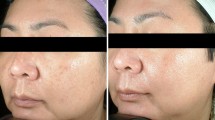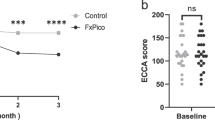Abstract
The efficacy of nonablative fractional laser resurfacing of acne scars has been described in case reports and uncontrolled trials. The present study is the first randomized controlled trial in this field. The aim of this study was to examine the efficacy and adverse effects of 1,540-nm nonablative fractional laser treatment of acne scars. Ten patients with acne scars were included. Two intraindividual areas of similar size and appearance within contralateral anatomical regions were randomized to (1) 3-monthly laser treatments with a StarLux 1,540-nm fractional handpiece, and (2) no treatment. Blinded on-site clinical evaluations were performed before treatment, and at 4 and 12 weeks after the final treatment. End-points were overall change in scar texture (from score 0, even texture, to 10, worst possible scarring), adverse effects, change in skin colour (from score 0, absent, to 10, worst possible), and patient satisfaction (from score 0, no satisfaction, to 10, best imaginable satisfaction). Before treatment, scars were moderately atrophic and uneven in texture on both treated and untreated sides (median score 6.5, interquartile range 4.5–8; P=1). After treatment, laser-treated scars appeared more even and smooth than untreated control areas (4.5, 2–6.5, versus 6.5, 4.5–8, P=0.0156, at 4 weeks; 4.5, 2.5–6.5, versus 6.5, 4.5–8, at 12 weeks; P=0.0313). Patients were satisfied with the treatment (5.5, 1–7, after 12 weeks) and five of the ten patients evaluated their acne scars as moderately or significantly improved. No differences were found in skin redness or pigmentation between before and after treatment. Patients experienced moderate pain, erythema, oedema, bullae, and crusts. No adverse effects were seen in untreated control areas. The nonablative 1,540-nm fractional laser improves acne scars with a minimum of adverse effects.



Similar content being viewed by others
References
Rivera AE (2008) Acne scarring: a review and current treatment modalities. J Am Acad Dermatol 59:659–676
Alster TS, Zaulyanov-Scanlon L (2007) Laser scar revision: a review. Dermatol Surg 33:131–140
Tanzi EL, Alster TS (2002) Treatment of atrophic facial scars with a dual-mode Er:YAG laser. Dermatol Surg 28:551–555
Alster TS, West TB (1996) Resurfacing of atrophic facial acne scars with a high-energy, pulsed carbon dioxide laser. Dermatol Surg 22:151–154
Alster TS, Nanni CA, Williams CM (1999) Comparison of four carbon dioxide resurfacing lasers. A clinical and histopathologic evaluation. Dermatol Surg 25:153–158
Alster T (1999) Clinical and histologic evaluation of six erbium:YAG lasers for cutaneous resurfacing. Lasers Surg Med 24:87–92
Khatri KA, Ross V, Grevelink JM et al (1999) Comparison of erbium:YAG and carbon dioxide lasers in resurfacing of facial rhytides. Arch Dermatol 135:391–397
Ross EV, Miller C, Meehan KP et al (2001) One-pass CO2 versus multiple-pass Er:YAG laser resurfacing in the treatment of rhytides: a comparison side-by-side study of pulsed CO2 and Er:YAG lasers. Dermatol Surg 27:709–715
Alster TS, Lupton JR (2002) Prevention and treatment of side effects and complications of cutaneous laser resurfacing. Plast Reconstr Surg 109:308–316
Lupton JR, Williams CM, Alster TS (2002) Nonablative laser skin resurfacing using a 1540 nm erbium glass laser: a clinical and histologic analysis. Dermatol Surg 28:833–835
Goldberg DJ (2000) Full-face nonablative dermal remodeling with a 1320 nm Nd:YAG laser. Dermatol Surg 26:915–918
Sadick NS (2003) Update on non-ablative light therapy for rejuvenation: a review. Lasers Surg Med 32:120–128
Hedelund L, Bjerring P, Egekvist H et al (2006) Ablative versus non-ablative treatment of perioral rhytides. A randomized controlled trial with long-term blinded clinical evaluations and non-invasive measurements. Lasers Surg Med 38:129–136
Grema H, Greve B, Raulin C (2003) Facial rhytides – subsurfacing or resurfacing? A review. Lasers Surg Med 32:405–412
Laubach HJ, Tannous Z, Anderson RR et al (2006) Skin responses to fractional photothermolysis. Lasers Surg Med 38:142–149
Alexiades-Armenakas MR, Dover JS, Arndt KA (2008) The spectrum of laser resurfacing: nonablative, fractional, and ablative laser resurfacing. J Am Acad Dermatol 58:719–738
Manstein D, Herron GS, Sink RK et al (2004) Fractional photothermolysis: a new concept for cutaneous remodeling using microscopic patterns of thermal injury. Lasers Surg Med 34:426–438
Bedi VP, Chan KF, Sink RK et al (2007) The effects of pulse energy variations on the dimensions of microscopic thermal treatment zones in nonablative fractional resurfacing. Lasers Surg Med 39:145–155
Tannous Z (2007) Fractional resurfacing. Clin Dermatol 25:480–486
Alster TS, Tanzi EL, Lazarus M (2007) The use of fractional laser photothermolysis for the treatment of atrophic scars. Dermatol Surg 33:295–299
Lee HS, Lee JH, Ahn GY et al (2008) Fractional photothermolysis for the treatment of acne scars: a report of 27 Korean patients. J Dermatol Treat 19:45–49
Hasegawa T, Matsukura T, Mizuno Y et al (2006) Clinical trial of a laser device called fractional photothermolysis system for acne scars. J Dermatol 33:623–627
Chrastil B, Glaich AS, Goldberg LH, Friedman PM (2008) Second-generation 1,550-nm fractional photothermolysis for the treatment of acne scars. Dermatol Surg 34:1327–1332
Cho SB, Lee JH, Choi MJ et al (2009) Efficacy of the fractional photothermolysis system with dynamic operating mode on acne scars and enlarged facial pores. Dermatol Surg 35:108–114
Walgrave SE, Ortiz AE, MacFalls HT et al (2009) Evaluation of a novel fractional resurfacing device for treatment of acne scarring. Lasers Surg Med 41:122–127
Chapas AM, Brightman L, Sukal S et al (2008) Successful treatment of acneiform scarring with CO2 ablative fractional resurfacing. Lasers Surg Med 40:381–386
Dreno B, Khammari A, Orain N et al (2007) ECCA grading scale: an original validated acne scar grading scale for clinical practice in dermatology. Dermatology 214:46–51
Min SU, Choi YS, Lee DH et al (2009) Comparison of a long-pulse Nd:YAG laser and a combined 585/1,064-nm laser for the treatment of acne scars: a randomized split-face clinical study. Dermatol Surg 35:1720–1727
Jih MH, Goldberg LH, Kimyai-Asadi A (2008) Fractional photothermolysis for photoaging of hands. Dermatol Surg 34:73–78
Wanner M, Tanzi EL, Alster TS (2007) Fractional photothermolysis: treatment of facial and nonfacial cutaneous photodamage with a 1,550-nm erbium-doped fiber laser. Dermatol Surg 33:23–28
Tanzi EL, Alster TS (2004) Comparison of a 1450-nm diode laser and a 1320-nm Nd:YAG laser in the treatment of atrophic facial scars: a prospective clinical and histologic study. Dermatol Surg 30:152–157
Acknowledgement
We are indebted to Jesper Andersen, MediTech Scandinavia, for assistance in establishing the treatment parameters. The authors also thank photographer Nis Kentorp for taking professional photographs. We are also grateful to MediTech, Scandinavia, Denmark, for a research grant and for providing on loan a StarLux 1540 nm fractionated handpiece, but the sponsor had no role in the design or conduct of the study, in the collection, analysis and interpretation of the data, or in the preparation, review and approval of the manuscript.
Conflict of Interest
Dr. Hædersdal received a research grant and a StarLux 1540 nm fractionated handpiece on loan from MediTech, Scandinavia, Denmark, to support this study. The authors have no relevant personal financial interest in this article.
Author information
Authors and Affiliations
Corresponding author
Rights and permissions
About this article
Cite this article
Hedelund, L., Moreau, K.E.R., Beyer, D.M. et al. Fractional nonablative 1,540-nm laser resurfacing of atrophic acne scars. A randomized controlled trial with blinded response evaluation. Lasers Med Sci 25, 749–754 (2010). https://doi.org/10.1007/s10103-010-0801-1
Received:
Accepted:
Published:
Issue Date:
DOI: https://doi.org/10.1007/s10103-010-0801-1




